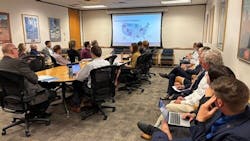Advanced Transmission Technologies Could Bring Utah Utilities Cost and Reliability Benefits
The Pew Charitable Trusts co-hosted a technical briefing for the Utah Public Service Commission in Salt Lake City, Utah to support implementation of advanced transmission technologies (ATTs).
The briefing featured presentations from Rocky Mountain Power (the local utility), national transmission policy organizations Grid Strategies and GridLab, and Pew staff, among others.
ATTs are a suite of software and hardware tools boosting the capacity of transmission lines to compress more electricity out of the grid and help add new resources.
Legislators in more than 15 states have passed bills to increase utilities' deployment of ATT's onto the transmission system, including in Utah, where Governor Spencer Cox (R) signed H.B. 212 into law. The law requires electric utilities in the state to analyze the cost-effectiveness and timeline for the deployment of ATTs in any proposal to expand the transmission system.
The state's Public Service Commission (PSC), the regulators looking after public utilities and their proposed investments, are asked to implement the law, meaning Utah is evaluating the technologies in the context of its utilities regulation system.
Julia Selker of the WATT Coalition, a trade organization for ATTs, gave an overview of the ATTs that Utah utilities should consider using to bolster its transmission system. She explained that the multiple types of ATTs all expand grid capacity and can be installed in short timelines of one to three years.
Selker also emphasized on advanced power flow controllers, which are small devices allowing operators to direct electricity flows to avoid congested areas of the grid. She also provided information about topology optimization, which uses sophisticated software to determine the best use of the transmission system based on available power sources, demand, and congestion.
Selker highlighted the benefits created by the technologies, including lower costs for consumers and the ability to bring new generation resources online swiftly.
Representatives from Rocky Mountain Power gave an overview of its parent company PacifiCorp's use of ATTs, including dynamic line rating (DLR) systems, which are small sensors installed along transmission lines to give grid operators real-time insights into temperature and weather conditions, enabling them to safely increase the amount of power flowing through the lines. PacifiCorp installed DLR in 2014 on a line in Wyoming, which allowed the line to carry more electricity, and has plans to implement DLR on additional lines.
The briefing also explained the role of advanced conductors, which use carbon or composite materials as compared to steel for the line core and increase the amount of electricity the lines are supposed to carry. Advanced conductors reduce the risk of wildfires as they do not sag in high temperatures, while steel-core lines soften and sag during extreme heat events as they come in contact with vegetation, presenting a major wildfire risk in Utah.
Moreover, as advanced conductors can be installed on existing poles utilities are allowed to use them to increase capacity without adding new transmission towers. PacifiCorp shared data showing that the company had deployed advanced conductors on approximately 300 miles of their transmission system in other states.
